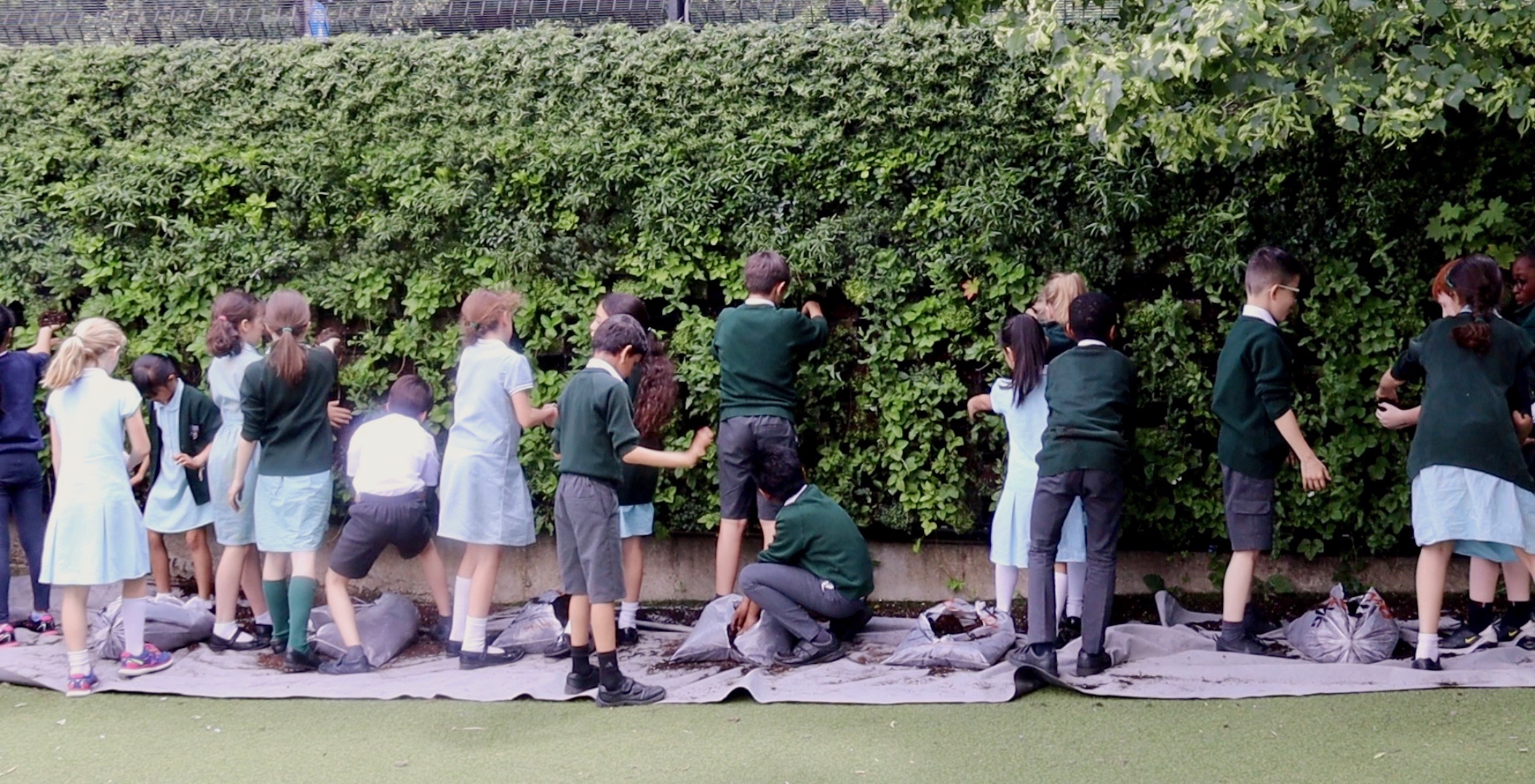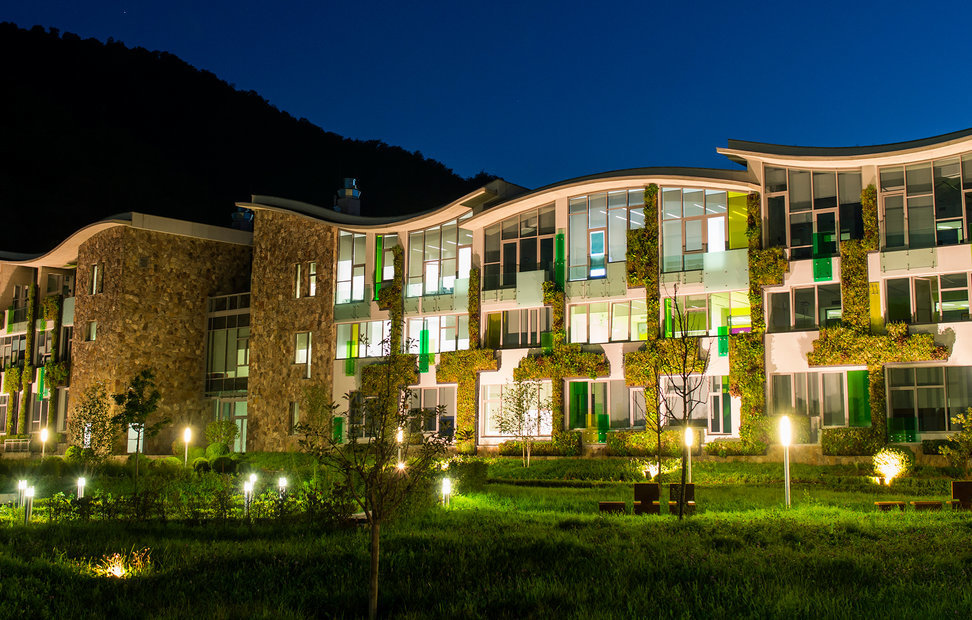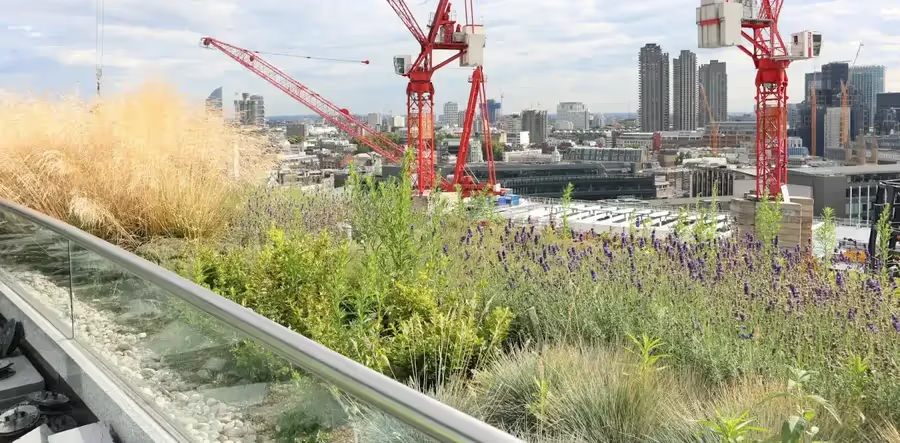Biophilic learning: Living walls in schools and educational settings

In a world where young people spend more time indoors than ever before, reimagining the spaces in which they learn is more than a design challenge. It is a call to reconnect with nature. Biophilic design, a concept that brings natural elements into built environments, is reshaping how we think about education.
There is a growing movement to make learning environments more connected with nature. From natural light and organic materials to sensory gardens and living walls, schools are increasingly embracing this evidence-based approach to create healthier, more engaging spaces for students and staff alike.
In this blog, we will explore what living walls are, why they matter in educational settings and how they support biophilic learning. From scientific research to real-life case studies, we will delve into the transformative power of nature in education, and how living walls can help schools grow greener, healthier futures for their students.
Rethinking educational environments
There is a growing movement that has seen schools embracing biophilic design to create healthier, more engaging spaces for student and staff alike.
Among the most striking and versatile features of biophilic design are living walls, which are vertical gardens that bring lush greenery directly into the learning environment. Not only do they transform the look and feel of a space, but they also offer tangible benefits for cognitive performance, mental health and environmental quality.

What are living walls
Living walls, also known as green walls or vertical gardens, are structures covered with plants, either rooted in soil beds or integrated into modular panels with built-in irrigation systems. More than just decorative features, living walls bring the calming presence of nature into built spaces. Transforming blank walls into vibrant, living ecosystems.
Plant choices for green walls
The selection of plants used in living walls depends on whether the installation is indoors or outdoors, as well as light levels and maintenance preferences. Common choices include:
- Ferns
- Pothos and philodendrons
- Spider plants and peace lilies
- Sedums and succulents
- Herbs and edible plants
Living walls in schools
In educational settings, living walls can be installed in a variety of spaces:
- Indoor living walls: Hallways, reception areas, libraries and classrooms. Turning underutilised walls into inspiring focal points.
- Outdoor living walls: Playground boundaries, courtyards or entrances. Enhancing biodiversity and kurb appeal while providing hands-on learning opportunities.
Whether inside or outside, living walls can be designed to reflect the school’s identity and values, creating a calming, creative environment that students and staff can thrive in.

The science behind biophilic learning
At the heart of biophilic design is a simple but powerful idea: humans have an innate need to connect with nature. This concept, known as biophilia, suggests that exposure to natural environments isn’t just pleasant, it’s essential to our psychological and cognitive wellbeing.
Why nature matters in education
In educational settings, where students spend hours indoors under artificial lighting and rigid structures, the absence of natural elements can lead to increased stress, reduced focus and lower levels of engagement.
Incorporating nature, through light, texture, patterns and especially greenery, helps counteract this, creating spaces that promote calm, curiosity and creativity.
What research shows
A growing body of research highlights the benefits of nature-connected learning environments:
- Improved focus and attention: Studies show that children exposed to natural elements perform better in tasks requiring concentration. Natural environments help reduce mental fatigue and improve sustained attention.
- Enhanced creativity and problem-solving: Time in or around green spaces has been linked to more flexible thinking and improved problem-solving abilities.
- Emotional and psychological benefits: Nature exposure has been proven to reduce cortisol levels, elevate mood and support mental health. In school settings, this translates into calmer classrooms and more positive student behaviour.
Greenery and academic performance
Beyond wellbeing, nature in schools can directly support academic achievement. A landmark study published in Frontiers in Psychology found that classrooms with living plants improved student performance in areas like maths, reading, and writing
The presence of greenery, particularly in forms like living walls, serves as more than just decoration. It acts as a silent supporter of focus, cognitive development, and emotional resilience.

Benefits of living walls in educational settings
Living walls do more than beautify a space, they actively contribute to a healthier, more engaging, and more supportive learning environment. When thoughtfully integrated into schools and educational settings, living walls can deliver a wide range of benefits that support both students and staff.
- Mental health and wellbeing: Living walls help reduce stress, anxiety and even symptoms of depression. Their natural textures, colours and movement foster a sense of tranquillity, offering moments of mental pause in otherwise busy school days.
- Air quality and acoustics: Plants act as natural air filters, absorbing carbon dioxide and pollutants while releasing oxygen. In indoor environments, living walls can significantly improve air quality. Plant-covered surfaces can also help absorb and diffuse sound, making classrooms and corridors quieter and more conducive to learning and focus.
- Engagement and attendance: Research has shown that nature-integrated environments can lead to improved behaviour, greater engagement and even better attendance. Living walls create inviting, dynamic spaces where students feel more comfortable and inspired.
- Aesthetics and school identity: Beyond their functional benefits, living walls make a strong visual statement. They can be designed to reflect a school’s values, such as sustainability, wellness or innovation.They can be integrated with signage, logos or even student-led planting projects. These green features help create memorable, inspiring spaces that students are proud to be part of and that visitors immediately connect with. A standout example is the University of Nottingham's living wall project. There, the living wall not only serves as a lush, vibrant centrepiece but also embodies the university's dedication to environmental responsibility and campus well being.
Schools using living walls effectively
As the benefits of biophilic design become more widely recognised, many schools and universities are already leading the way, by integrating living walls to enhance learning, wellbeing and sustainability. Two standout examples demonstrate how these green features can make a measurable difference in both primary and higher education settings.
Bromley High Junior School
Viritopia partnered with IID Architects to bring a 25 m² exterior living wall to the north-facing visitor entrance of Bromley High Junior School. The entrance area had been dominated by a large, windowless brick façade, creating a cold and less welcoming first impression.
To address this, the living wall was designed with shading in mind, using shade-loving plant species to deliver a sophisticated, textured finish that complements the school’s emphasis on biophilic design, natural light and open learning spaces.
Outcomes and benefits:
- Transformed entrance ambience, turning a stark façade into a welcoming focal point that enhances school identity and visitor experience.
- Elevated biophilic design continuity, aligning indoor learning spaces filled with natural light with the building’s exterior green feature.
- Improved emotional impact and engagement, as students, staff and visitors benefit from seeing living greenery right at the entrance, signalling a calm, thoughtful learning environment.
University of Hull
At the University of Hull, a major exterior living wall was installed to create a biophilic, biodiversity-friendly space that enhances both wellbeing and the campus environment.
The aims of this living wall installation were to:
- Improve concentration
- Boost wellbeing for the students and staff
- Support biodiversity
These case studies illustrate how living walls can deliver a meaningful experience across different educational levels. Whether transforming a welcoming entrance or revitalising outdoor spaces, green elements make learning environments more attractive, supportive and conducive to both cognitive and emotional growth.

Educational opportunities through living walls
Living walls are more than beautiful additions to school buildings, they are living, breathing teaching tools. With the right approach, these installations can support hands-on learning, inspire curiosity about the natural world and reinforce sustainability values across a wide range of subjects.
Student involvement and ownership
One of the most powerful benefits of a living wall is the opportunity it provides for active student participation. Involving students in the maintenance, monitoring and care of the wall fosters a strong sense of ownership and responsibility.
Tasks like trimming, recording plant growth and monitoring biodiversity not only encourage stewardship but also support the development of practical life skills and teamwork.
Curriculum integration
Living walls align naturally within multiple areas of the curriculum and can be used to deliver both theoretical and experiential learning.
- Biology and life sciences: Students can learn about the role of plants in air purification, observe plant growth cycles or study pollination.
- Environmental science and sustainability: Living walls can encourage discussions about urban greening and biodiversity enhancement.
- Geography and design technology: Students can study green infrastructure in urban planning, design planting schemes as part of design challenges or investigate how built environments interact with nature.
- Citizenship and PSHE: Living walls can introduce discussions around sustainability, global responsibility and environmental ethics. As well as promoting student wellbeing through a connection to nature.
Implementation considerations
While the benefits of living walls are substantial, thoughtful planning is essential to ensure long-term success. Schools considering a green wall project should keep a couple of key factors in mind.
1. Maintenance
A thriving living wall depends on regular and effective care. Without proper maintenance, even the most beautiful installation can quickly lose its impact. Consider:
- Automated irrigation systems to ensure consistent watering and nutrient delivery
- Scheduled plant care, including trimming, replanting and health checks
- Professional maintenance support, particularly for schools without dedicated horticultural staff
Many schools opt to work with experienced providers like Viritopia, who offer tailored maintenance packages to keep walls vibrant and worry-free year-round.
2. Choosing the right location and plants
The success of a living wall is closely tied to where it is placed and what it is planted with. To get the most out of your green wall:
- Assess light conditions
- Think about visibility and access
- Choose low-maintenance, resilient plant species
Early consultation with a living wall expert can help ensure your choices align with both environmental conditions and educational goals.
How Viritopia can help
At Viritopia, we specialise in bringing biophilic design to life through bespoke living wall solutions. With extensive experience in educational settings, we understand the unique needs of schools, colleges and universities.
Whether your goal is to:
- Create a visual centrepiece
- Improve student wellbeing
- Support curriculum goals
- Demonstrate your commitment to sustainability
Viritopia provides customised living wall systems that deliver lasting value.
We work closely with schools to ensure every project supports both the physical space and the educational mission behind it.
Growing a greener future for education
As schools look to create healthier, more inspiring environments, biophilic design offers a clear path forward. Living walls bring nature into the heart of education by improving wellbeing, boosting performance and sparking curiosity in the next generation.
Whether you are exploring your first green feature or ready to scale up a sustainability initiative, living walls are a meaningful investment in your school’s future. Get in touch to explore what is possible for your school.
Explore more insights
Discover the latest in green infrastructure

Vanguard Logistics Park (Longmore) Featured in RIBA Commercial Directory 2025

Green Roof Advantages & Disadvantages

Design with meaning: How office living walls reflect your brand

